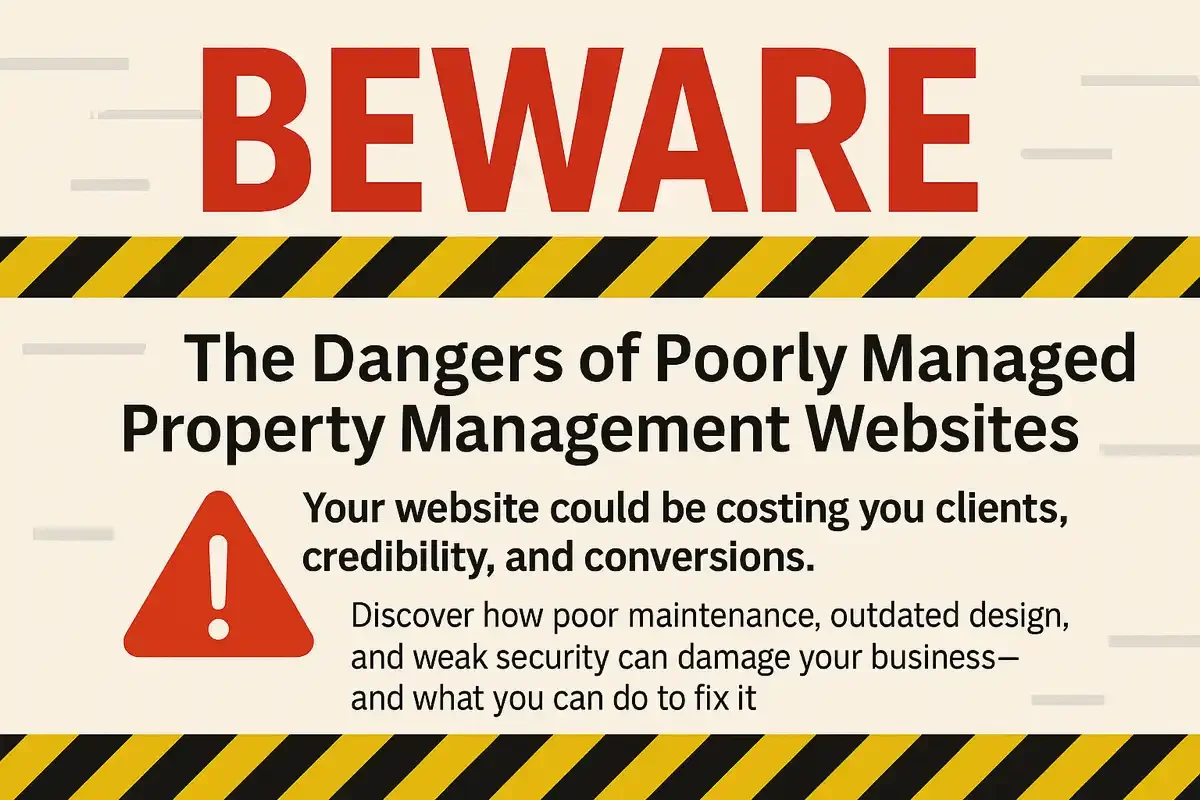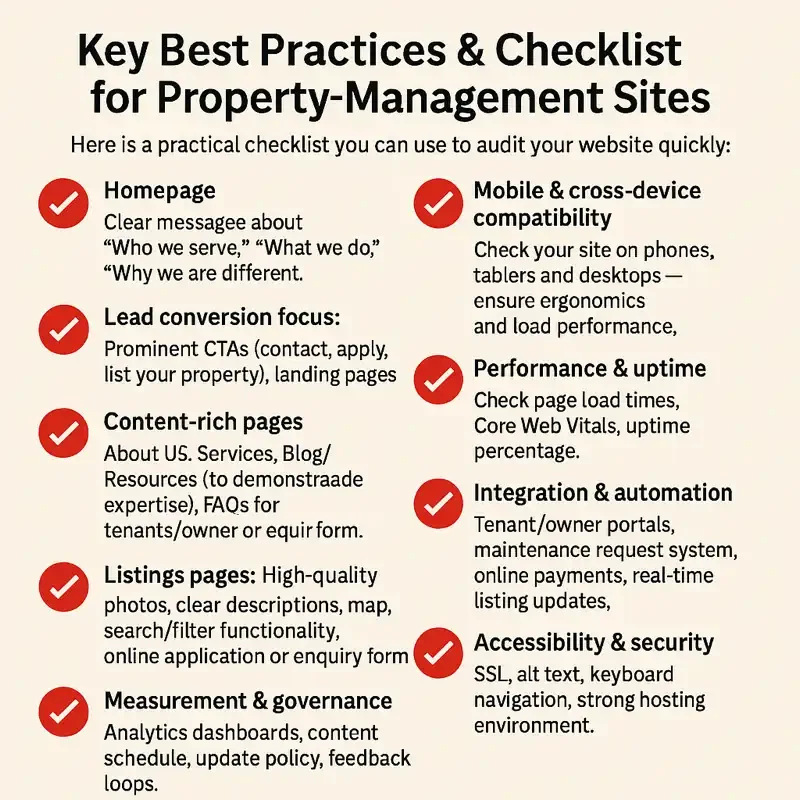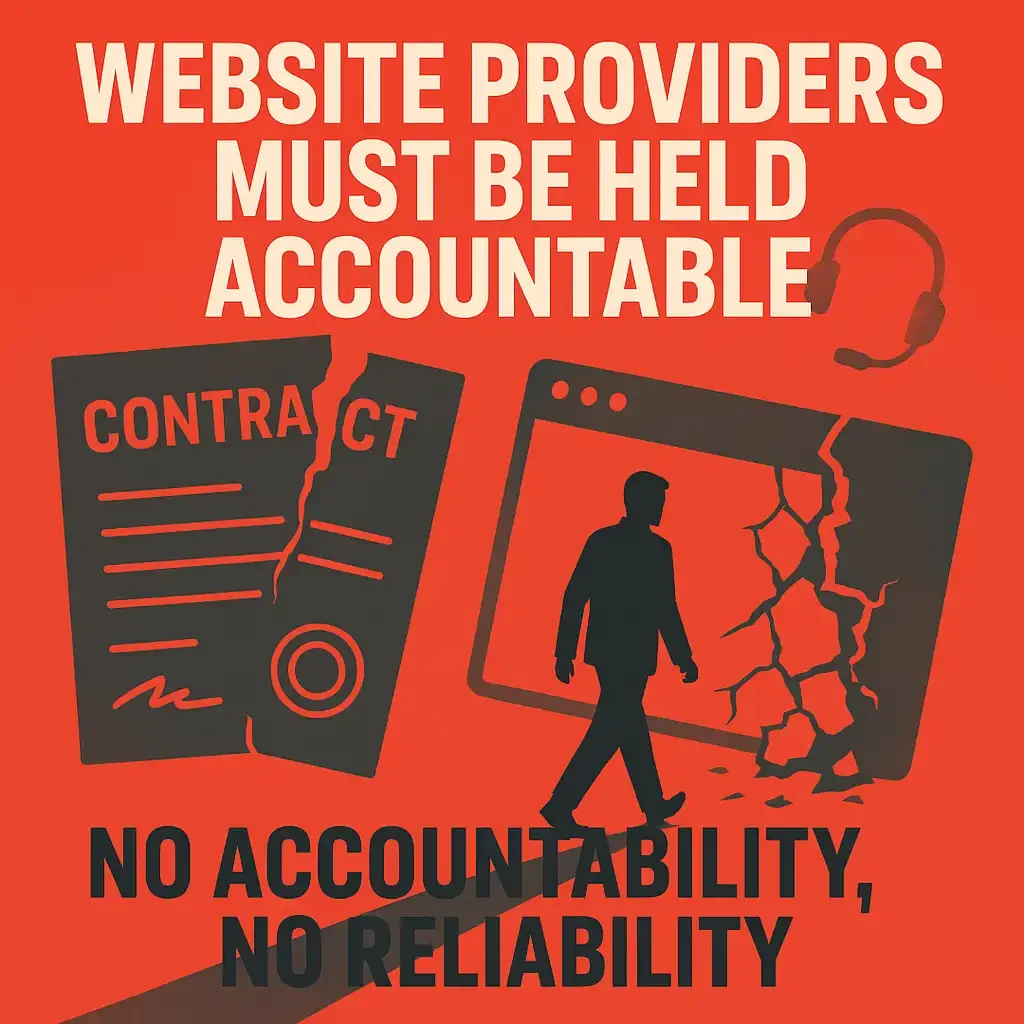The Dangers of Poorly‑Managed Property Management Websites
A poorly managed property management website can silently sabotage your business. From confusing navigation and slow load times to outdated designs and unresponsive layouts, a subpar digital presence undermines trust, deters leads, and weakens client relationships. This in-depth guide explores the tell-tale signs of a failing website, the business risks involved, how to fix them, and why holding your web provider accountable is critical. Learn how to transform your website into a reliable, lead-generating asset that reflects your professionalism and supports long-term growth.
Table of Contents
Introduction
In today’s digital age, your website serves as the front door to your business — and for property‑management firms, this is especially true. A well‑designed, responsive, and efficient website can become a powerful asset. Conversely, a poorly managed website can not only reduce client engagement and lead generation — it can damage your reputation, signal disorganization, and cost you business. This article explores the common pitfalls of property‑management websites and offers concrete steps to fix them, enabling you to enhance user experience, client trust and overall business performance.
1. Why a Well‑Structured Website Matters for Property Management
Your website is often the first touchpoint for two key stakeholder groups: property owners (who entrust you with their assets) and prospective tenants (who might rent through you). Because of this dual audience, structure and clarity matter even more than in many other industries.
First Impressions Matter.
When a potential property owner visits your site for the first time, what they see — the layout, design quality, clarity of messaging — will shape their initial judgement of your professionalism. A clean, professional design conveys trust and competence, crucial factors in the property‑management industry.
User Experience & Accessibility.
A site that is user‑friendly and accessible to all users — including those with disabilities — broadens your potential audience and improves satisfaction. Ensuring accessible navigation, alt‑text for images, clear fonts and sufficient contrast supports inclusive design and reflects well on your brand.
Mobile Responsiveness.
With a significant and growing portion of users accessing websites via mobile devices, responsiveness is non‑optional. A site that adapts seamlessly across screen sizes ensures consistent experience, regardless of device. If your site looks or functions poorly on mobile, you risk losing visitors — and potential clients.
In short: a well‑structured site is foundational. Without it, any other marketing effort may leak value.
2. Signs of a Poorly Managed Property‑Management Website
How do you recognize a website that is underperforming? These are tell‑tale signs that your site may be hurting rather than helping your business.
Usability Problems
Complex Navigation: If your menus are hidden, disjointed or overly deep (e.g., multiple sub‑levels), users may get lost trying to find what they need. Simplifying navigation helps users locate key information quickly.
Cluttered Layouts: Too many elements, competing illustrations, irrelevant content or crowded pages overwhelm visitors. Streamlining and using whitespace effectively improves readability and focus.
Unresponsive Design: When the site doesn’t adapt properly to mobile browsers, tablet screens or different resolutions, visitors may abandon it quickly. Ensuring all elements (text, buttons, forms) scale and function well is essential.
Design & Branding Issues
Visual Appeal and Branding Inconsistencies: If your fonts, colours and imagery don’t match your brand identity — or worse, appear outdated — visitors may subconsciously perceive you as less credible.
Lack of Intuitive Navigation: Weak logic in how information is presented — for example mixing tenant content and owner content without clear distinction — can confuse both audiences and reduce conversion.
Engaging Content Short‑Fall: If the content is thin, generic, or lacks value (e.g., little local insight, poor imagery, no blog or resource section), you fail to capture visitor interest or demonstrate expertise.
Performance & SEO Problems
Slow Loading Times: Pages that load slowly frustrate users and increase bounce rate. Modern users expect near‑instant responses; lag means lost opportunities.
Frequent Downtime / Unreliable Hosting: If the site is often unavailable, you risk losing credibility and harming search‑engine rankings.
Poor SEO Visibility: If you lack proper meta tags, local‑area targeting, optimized listings content or good site architecture, you may never reach prospects searching for “property management [city]”. Without visibility, your site cannot perform as a business asset.
Each of these issues points toward a website that is not just inefficient — but undermining your brand.
3. The Business Consequences of a Sub‑Par Website
A poorly managed website doesn’t stay online in isolation — its adverse effects ripple across your business.
Perception of Competence
A visually unattractive or technically flawed site suggests a lack of attention to detail. Property owners may infer that if you can’t manage your online presence, you may not manage their assets competently. The website becomes a proxy for your operational reliability.
Erosion of Trust & Client Satisfaction
Trust is fundamental in property management. If clients (owners or tenants) see a site with broken links, outdated listings or confusing navigation, they may doubt your responsiveness or organization. This damages long‑term relationships and referrals
Competitive Disadvantage
The property‑management industry is competitive. Firms with polished, modern websites stand out and command stronger leads and owner contracts. A sub‑par website puts you behind before you even engage prospects.
Undermining Marketing & Lead Generation
Your website is the hub of your digital marketing. Poor design or function means you lose the return on investment (ROI) from ads, SEO, social media or referrals. Visitors who arrive but bounce quickly are wasted leads.
In essence: neglecting your website doesn’t just cost you a few clicks — it impairs your ability to build trust, differentiate your brand and grow sustainably.
4. How to Fix & Improve Your Property‑Management Website
The good news: these problems are fixable. Here are concrete steps for improvement across design, usability, performance and operations.
Design & User‑Centric Improvements
Adopt a clean, modern aesthetic aligned with your brand identity. Consistent fonts, colors, imagery and tone matter.
Simplify navigation: Distinguish content for owners and tenants. Use clear menu labels, search/filter options for listings.
Ensure mobile‑first and responsive design, optimizing for readability and functionality across devices.
Usability & Functional Enhancements
Use logical categorization: separate resources for tenants, owners, property listings and contact forms.
Incorporate interactive features: advanced search filters (location, price, amenities), virtual tours/maps, tenant/owner portals. For example, when redesigning a property‑management site it is recommended to include features like listing search filters, online applications and portals.
Provide feedback mechanisms: contact forms, chatbots or survey prompts enabling visitors to share site‑experience insights.
Performance & Technical/SEO Optimisation
Optimize page‑load speeds: compress/resize images, enable browser caching, leverage a content‑delivery network (CDN).
Choose reliable hosting and ensure high uptime — benchmarks matter. For example, a site might aim for 99.9% uptime or higher.
Conduct technical SEO: keyword research (especially long‑tail keywords such as “property management companies in [city]”). Include meta‑titles, alt‑text, H1 tags, sitemap and mobile‑friendly architecture.
Ensure accessibility (WCAG compliance): alt text, sufficient contrast, keyboard navigation, clear heading structure.
Maintain strong security: SSL certificate, regular updates, secure portals for tenants/owners.
Technology & Integration
Use property‑management software integrated with your website so listings, availability and applications update in real time.
Implement analytics tools to track user behaviour, site‑performance metrics (bounce rate, time‑on‑site, conversion funnels) and use data to shape improvements.
Automate routine tasks: chatbots, automated responses, lead‑capture workflows. This supports efficiency and improves user experience.
Ongoing Maintenance and Governance
A website is not a “build once and forget” project. Schedule regular updates: refresh content, review features, audit performance metrics.
Establish governance: define roles/responsibilities for content updates, technical monitoring, performance dashboards. The concept of website governance emphasizes ongoing systems, policies and workflows.
Solicit user feedback periodically — clients and tenants can surface real‑world usability problems you might miss. Use insights to iterate and improve.
5. Key Best Practices & Checklist for Property‑Management Sites
Here is a practical checklist you can use to audit your website quickly:
Homepage: Clear message about “Who we serve,” “What we do,” “Why we are different.”
Lead conversion focus: Prominent CTAs (contact, apply, list your property), landing pages targeted at owners & tenants.
Content‑rich pages: About Us, Services, Blog/Resources (to demonstrate expertise), FAQs for tenants/owners.
Listings pages: High‑quality photos, clear descriptions, map, search/filter functionality, online application or enquiry form.
Mobile & cross‑device compatibility: Check your site on phones, tablets and desktops — ensure ergonomics and load performance.
Performance & uptime: Check page load times, Core Web Vitals, uptime percentage.
Integration & automation: Tenant/owner portals, maintenance request system, online payments, real‑time listing updates.
Local SEO: Service‑area landing pages, geo‑targeted keywords, local listing schema, meta tags.
Accessibility & security: SSL, alt text, keyboard navigation, strong hosting environment.
Measurement & governance: Analytics dashboards, content schedule, update policy, feedback loops.
Using this checklist enables you (or your web‑team) to systematically evaluate your site and prioritize improvements.
6. Accountability: Holding Website Providers Responsible for Poor Performance
Often, property‑management companies outsource website building or ongoing maintenance to agencies or freelancers. While this is a smart move, it also requires accountability. If your provider delivers a substandard site, you must know how to hold them accountable — and how to avoid such issues in future.
Understanding Your Provider’s Role
Your web agency or developer should deliver not just a “finished website” but a website that meets agreed‑upon standards of usability, performance, responsiveness, and SEO. If the site fails on these core fronts, the provider has not met expectations.
Common Failures by Web Providers
Providers might deliver sites with:
Outdated themes/templates that lack modern responsive support.
Poor mobile optimization or site‑structure neglect.
Minimal attention to SEO, meta tags, alt text, site‑speed or site‑architecture.
Lack of clear navigation or improperly categorized content (leading to confusion).
No clear plan for ongoing updates, backups or performance monitoring.
Contractual Clarity & Benchmarks
Your contract should include a Service Level Agreement (SLA) (or equivalent) that defines performance benchmarks — uptime, load speed, responsiveness, update timelines, SEO‑benchmarks and availability of support. An SLA provides accountability with measurable metrics.
For example: “Website must achieve 99.9% uptime; page‑load time on mobile under 3 seconds; responsive on devices; weekly content review; monthly SEO report.”
Accountability in Ongoing Management
Require periodic performance reports from your provider: uptime logs, site‑speed data, analytics reports, bounce‑rate trends.
Set remediation procedures: if performance dips below benchmarks, provider must respond within defined hours or incur service‑credits.
Clarify roles and responsibilities: who handles content updates, who handles technical fixes, what happens if provider delays corrective work.
When to Reconsider Your Provider
If you observe any of these warning‑signs, it’s time to evaluate whether you should switch:
Recurring downtime, sluggish load times or mobile display issues despite raising them.
Missed deadlines or lack of communication about updates, backups or security patches.
No proactive suggestions from your provider to keep your site up to date with emerging standards (mobile, Core Web Vitals, new CMS versions).
Lack of transparency in performance data — if you cannot access uptime or speed reports, you are not being held to account.
How to Vet or Switch to a Reliable Web Provider
Look for providers with property‑management niche experience: case studies showing modern responsive sites, conversion‑focused landing pages, SEO for property‑management.
Ask for references and examples of live websites where they improved performance metrics (load speed, SEO ranking, conversion rates).
Ensure your contract includes measurable KPIs and SLA terms (uptime, load, mobile responsiveness, support response time) — and consequences for non‑compliance.
Ensure ongoing governance plan: regular content updates, CMS/ plugin maintenance, analytics review, feedback cycles.
By taking this structured approach, you ensure that your website provider is not just “build and leave” but accountable for performance and continuous improvement.
7. Wrapping Up: Why Investing in Your Website is Strategic & Long‑Term
Your website is more than just a digital business card. For property‑management companies, it functions as your storefront, lead generator, service portal and brand ambassador. When your website is poorly managed, you suffer on multiple fronts: lost leads, damaged reputation, weaker trust, and less competitive positioning.
On the flip side — by addressing design, usability, performance, integration and accountability — you transform your website into a growth engine. You attract more property‑owners by demonstrating professionalism, serve tenants more effectively, and scale your business with digital confidence.
Remember: a website isn’t a one‑and‑done project. It requires ongoing attention. Regular audits, technical updates, content refreshes and performance monitoring keep it in top shape. In a market where potential clients often judge you by your website before speaking with you, investing in a well‑managed website is a strategic move — not just a digital necessity.
Start with a website audit today. Use the checklist above, identify weak points, set clear goals for improvement, hold your provider accountable, and move ahead with the upgrades that will give your business a stronger online footing.
Want a Property Management Website That Works?
Don’t let your website hold you back. Schedule a personalized strategy call with Clearlead Digital and discover how we can elevate your online presence.
Schedule Your Free Website ReviewFrequently Asked Questions (FAQs)
-
It depends on your market, technology changes and performance metrics. As a general rule, a full redesign every 3‑5 years is reasonable — but you should perform minor updates (content refreshes, plugin updates, performance tweaks) annually or semi‑annually.
-
A competitive target is a mobile‑load time under 3 seconds, ideally closer to 2 seconds or less. Additionally, aim to meet Google’s Core Web Vitals (Largest Contentful Paint, First Input Delay, Cumulative Layout Shift).
-
Very important. Property‑management clients are location‑specific (city, neighbourhood etc.), so using geo‑targeted keywords, service‑area pages, local landing pages and citations is critical to ranking for “property management [city]”.
-
If you have the internal expertise, time and resources to maintain design, performance, mobile responsiveness and SEO, building in‑house might work. But for most property‑management firms, hiring a professional agency experienced in this niche will yield better results and fewer headaches.
-
Track metrics such as bounce rate, time‐on‑site, number of leads generated, conversion rate (visitor→inquiry→client), page‑load time, mobile vs desktop performance, uptime, mobile usability. Use these to compare before/after improvements and fine‑tune continuously.



